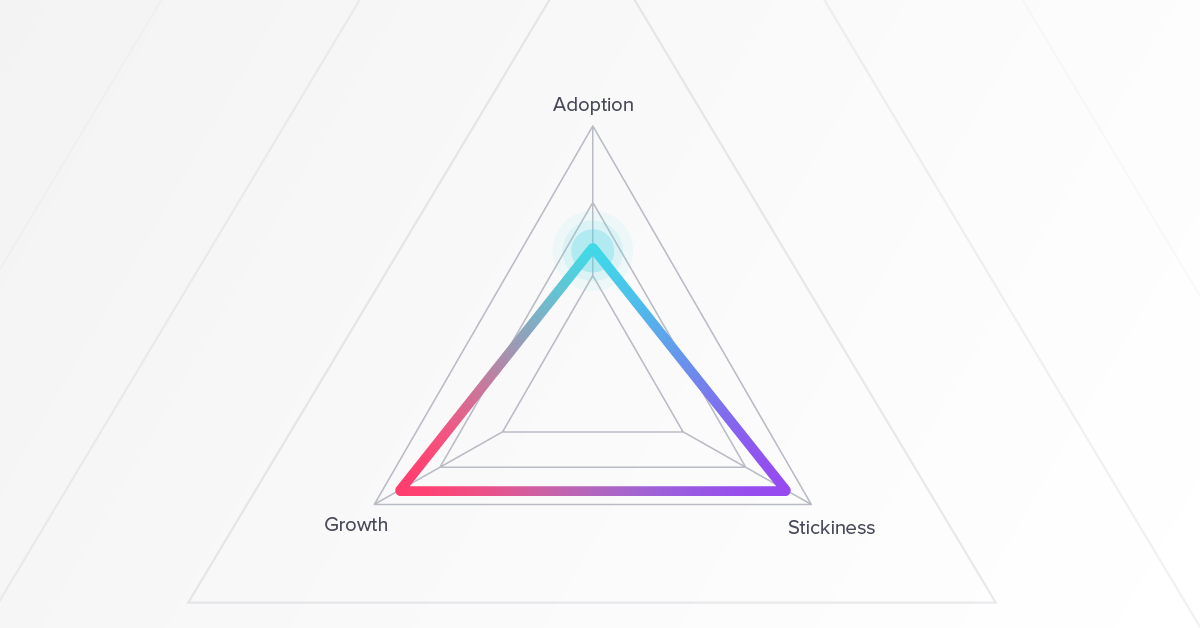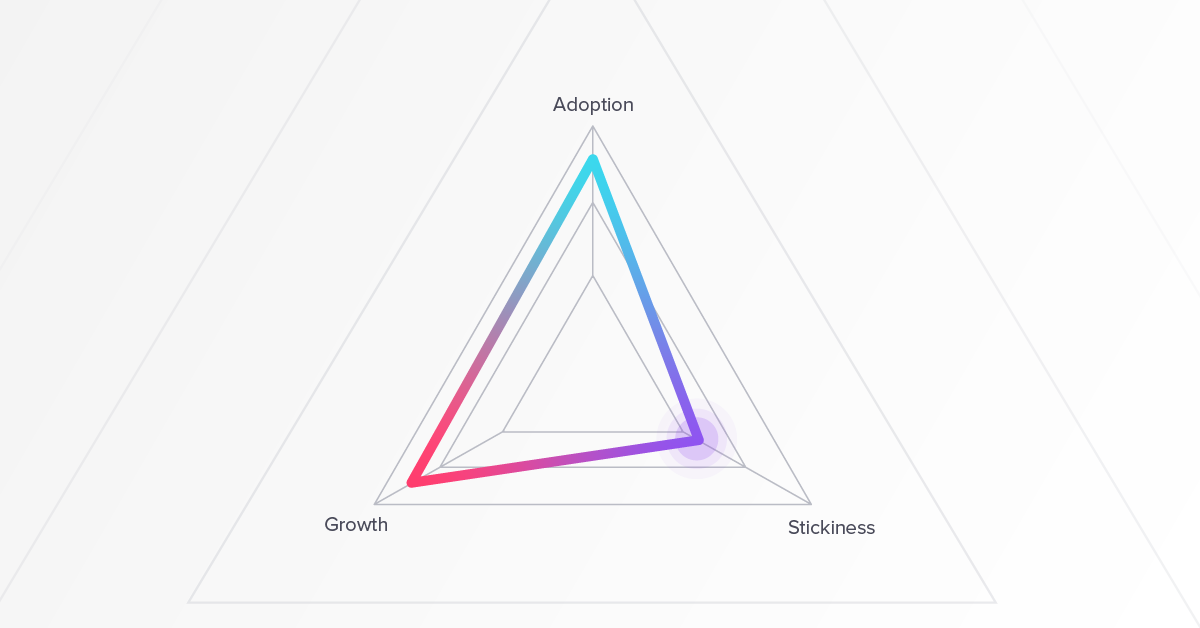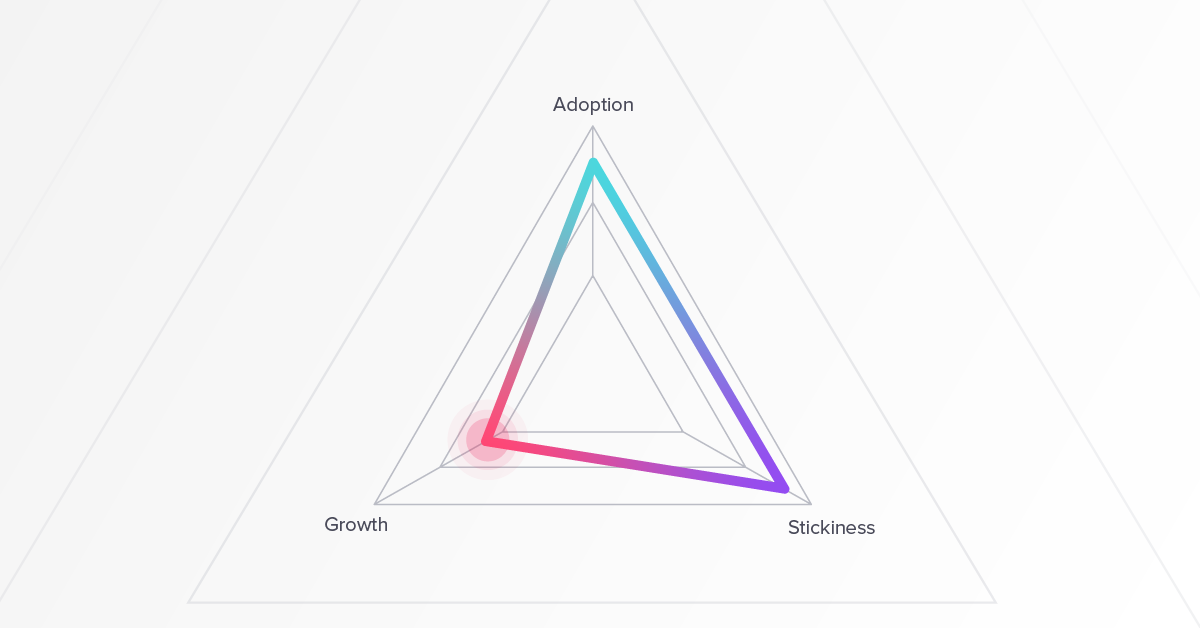Although report cards often meant the dread of seeing a less-than-stellar grade, they offer a useful framework for identifying areas of improvement: a grade for each class you’re taking, plus an overall performance score (your GPA). In this same vein, Pendo created the product engagement score (PES) to give product leaders a single metric that measures how users engage with the product, just as NPS is a single metric that measures user sentiment.
While a benefit of PES is that boils engagement down to one number, it’s equally useful in helping you understand where you can improve. Since the score takes the average of a product’s adoption, stickiness, and growth values, you can quickly identify which metric (or metrics) is bringing down the average.
So, what does your PES triangle look like right now? Maybe it’s equilateral with all three metrics at peak levels. This is the ideal scenario–but it’s also pretty unlikely. More often that not, one or more of the values that make up your product engagement score will be lower than the rest, allowing you to hone in on where you can get better. A good rule of thumb is to revisit your score at least as often as the time period you use to calculate it. For example, if your PES is based on the last 30 days of activity, examine it monthly to measure progress.
In the spirit of continuous improvement, below are tips for boosting your product engagement score–whether you’re focused on adoption, stickiness, growth, or a combination of the three.
Scenario 1: Low adoption

If the top of your PES triangle looks like it’s being pulled into the center by a magnet, you should turn your attention to adoption. This is measured by the average number of Core Events in your product adopted across all active visitors or accounts. One of the first questions you should ask is how your team is currently educating users about these core features.
Revisit your onboarding process, which is a crucial time in the customer journey to drive adoption. Successful onboarding should lead new users toward the personal realization of a product’s value proposition. As you examine your Core Events data, look into which Core Event takes the longest for users to discover, as well as how different segments of users discover Core Events differently. From there, you can work to build more personalized–and effective–onboarding flows.
Action items for improving adoption:
-
- Identify which features, actions, or workflows are most important for user success
- Map the customer journey for discovering and experiencing those features
- Evaluate your current (or create new) in-product messaging that supports feature discovery and adoption
Scenario 2: Low stickiness 
Stickiness is all about making your product a key part of users’ workflows. The more your users rely on your product to complete daily tasks, the more likely they’ll be to engage with it on a regular basis. When it comes to improving this metric, the first place to start is to explore the behaviors of your highest-frequency users. With this insight, you’ll know which workflows drive more frequent interactions, and can then work to steer other users toward these actions in the product.
Another useful tool is to think about your product’s trigger loop: What information can you proactively nudge users with that will get them to return and explore the product? Examples of this include products that notify users when they’ve been tagged in a photo, share weekly profile views, or release your team’s activity summary.
Action items for improving stickiness:
-
- Look into which features are used by those who access your product most frequently (What do they do that infrequent users don’t?)
- Identify the in-product habits users should be developing
- Leverage external channels or programs to nudge users back into your product
Scenario 3: Low growth

For increasing your growth value, it’s important to first determine where the issue lies. Are you struggling to add new users, or keep the ones you have?
If it’s the former, partner with your colleagues in marketing and sales to strategize around increasing the number of new users trying your product. This is also where having a free version of your product is valuable, since users can experience your product and, hopefully, see enough value that they are inclined to purchase the paid version. In this case, think about how you can offer upgrade options at natural points in users’ workflows.
If you’re seeing high levels of churn from existing users, work with marketing and customer success to identify ways to improve retention. Use product data to proactively identify users who are at risk, and then leverage in-app messaging to provide relevant resources and help users discover more value in the product. When low retention is dragging down otherwise healthy acquisition, it’s also important to define what an activated user looks like. By determining which milestones and sequences of events drive successful onboarding and adoption, you’ll be better equipped to ensure users stick around.
Action items for improving growth:
-
- Determine if your growth is more challenged by low user acquisition or retention
- If your focus is on user acquisition, consider experiments to promote viral sharing. What incentives can you offer users to add teammates or friends?
- If your focus is on retention, identify where there is drop off in order to better understand why users are churning
When more than one metric needs improving
Realistically, there won’t always be one clear part of your PES that needs improving the most. When it comes time to decide which to tackle first, there are a few ways to approach prioritization. In general, we recommend starting with adoption. If people aren’t getting to the “good” parts of your product, they won’t find the value they need to keep returning. Make sure the features you’re driving them to (aka your Core Events) are the ones that have a positive impact on long-term retention.
For more information on PES, visit our help documentation or reach out to [email protected] with any questions.


